|
Whirlwind, Camelot
Sunday, February 25, 2007
What can you do to create a coaster that grabs visitors' attention? A dozen inversions? 300ft drops? Maybe, but these things don't come cheap, and not every park has that sort of money hidden under the mattress. No, a lot of parks need to find a cheaper way of turning heads. One such park is Camelot. Sitting in Lancashire, the park has always suffered from the fact that it sits only a half hour drive away from one of the world's greatest amusement parks, Blackpool Pleasure Beach, not to mention BPB's sister park, Southport Pleasureland. It takes a lot to impress a public already au fait with The Big One, Grand National, or Cyclone, and Camelot has never really had anything in the same league. When it opened, Camelot was owned by Granada, and consisted of a very limited array of kiddie rides. The only ride of any note was "Dragon Flyer", a bizarre and surprisingly peppy powered coaster circling almost the entire park. After a few years, the park expanded, opening some real thrill rides in "Land of the Brave", a new area behind the original park. This was quite a masterstroke, as any large rides placed here are clearly visible from the M6 motorway and act as giant billboards for the park. For years, this area played host to the park's star attraction, "Tower of Terror". Not a drop tower as you might think, but a Shwarzkopf Silver Arrow coaster, with its loop cleverly concealed inside an impressive three dimensional castle facade. Only the most observant riders ever realised the ride went upside down until it was too late to back down. Although not Earth-shattering, it was a very enjoyable ride. Unfortunately, both the Tower of Terror and the nearby Excalibur spin ride were only there on hire, and eventually the owners wanted them back, leaving Camelot and its new owners, Prime Resorts, without a ride of any real significance. As such, visitors in 2001 and 2002 were offered no rides capable of really grabbing their attention. Other than Dragon Flyer, the only large ride was "The Gauntlet", a Pinfari coaster of the same infamous design as Drayton Manor's "Klondike Mine" or Brighton Pier's "Turbo". Obviously, this was far from ideal! Meanwhile in Germany, Maurer Sohne, were enjoying considerable success on the German fair scene with their "Spinning Coaster 2000" rides. Fitting the footprint of the firm's highly successful Wild Mouse, the ride included steeply banked drops and helices, and was designed to make use of the firm's new 4-seat spinning cars, originally offered as an add-on for their Wild Mouse rides. A disagreement with a showman, however, had seen the company repossess one of the earlier models of the ride. So, Camelot had a space left by a reclaimed ride, while Maurer had a reclaimed ride looking for a home. It doesn't take a genius to work out what happened next. The ride opened in 2003, and was a real fluke for the park, as they came out of the deal with a ride that had earned a very good reputation in Germany, and could be claimed as a genuine first for a UK park. As if to highlight the brilliance of the park's timing, Tussaud's were already talking to Maurer about similar rides for 2004 at Chessington and Alton Towers, yet Camelot had come from nowhere and found themselves in a very enviable position, a real triumph of opportunism. When you visit Camelot, there is a distinct sense that the place had been intended as a "real" theme park, and has gradually abandoned the idea. From the entrance, you pass through the courtyard, past an attractive mini-castle and the Go-Karts(!), then down into the original park and over a bridge into the newer section. As you arrive in Land of the Brave, nothing really hints at the idea of mediaeval theming other than the ride names and backflashes. The rides themselves all appear exactly as they would on the fairgrounds - not a bad thing in itself, but very out of place in what is supposed to be a "proper" theme park. Whirlwind sits neatly on a little plateau that was originally home to Excalibur (a Weber Dreamboat). This makes the ride look very impressive, and much taller than it actually is. The ride is placed side-on from the pathways, meaning that the station is at the side of the ride, rather than the front, and the lift hill is at the back. The entrance is through a small archway (left over from the Excalibur entrance), which leads around to the left of the ride. Until now, you would be forgiven for not realising that the ride had come from the fair circuit. When you near the station, however, it becomes comically obvious. Camelot's attempts to tailor the ride to the site amount to nothing more than a new name sign at the top of the lift hill, and the addition of the park's logo to the side of each car. The ride even uses the same queue system as on the fairs, a metal floored cattle pen, zig-zagging in front of a station that has very obviously been unfolded from a truck - you can even see the truck's wheels and luggage compartments. OK, it's forgivable for an ex-travelling coaster to have a temporary look, but Whirlwind actually seems to go out of its way to contradict the park's mediaeval theme. For example, Lara Croft-style artwork hanging from the station fences might look good at a fair or unthemed park, but looks totally out of place here, as does the Maurer plaque giving details of the ride in German (or is it Chaucerian English?). With such a blatant disregard for the Camelot theme, it's actually surprising not to see a fairground paybox at the ride entrance, telling people in German that the ride still costs 4 Euros per person. Still, there is one real advantage of buying an ex-fair ride, and that's capacity. If you've ever seen the kind of crowds that German fairs can attract, you'll understand why the rides need to get through the queues like lightning. To that end, Whirlwind is capable of running with seven four-seater cars at once. Sadly, few theme parks ever bother to run rides to capacity, and so my visit saw a mere four cars on-track. Not only that, the staff insisted that only two people could ride in each car, turning a queue of about 100 people into a very slow and irritating long wait. It's one thing to know that a park is doing its best with a low-capacity ride, but it's another to see a coaster operate with less than a third of its seats available for use. Worse still, as you shuffle along this slow moving queue, there is very little of the ride visible - or any the park's other rides for that matter. It is a shame that the ride should look so good from a distance, yet nothing has been done to make the ride particularly easy-on-the-eye when you get near it. Spectators can only view the ride from one side, and even then high fences make the ride seem quite uninviting. Again lacking any sort of Camelot theming, the cars appear exactly as they would on the fair circuit. Fortunately, they look very stylish, albeit totally out-of-sync with the park's mediaeval theme. Recalling the ride's Wild Mouse heritage, many of the cars have cleverly designed smiley mouse-faces painted on them, their eyes formed by the oval grab-rails attached to the lap-bars. This subtle and slightly odd humour is very characteristic of German fair rides, and is a welcome sight on these shores. The cars are slightly awkward to board, but very comfortable once you are in. The back-to-back seating arrangement certainly offers a far more exposed feel than Reverchon's Waltzer-style cars. The lap bars are unobtrusive, and the lack of arm-space means that holding the grab-rail is definitely the most comfortable way to ride. Before long, you head out of the station and head straight for the express-speed lift hill. As with the Reverchon spinning coasters, the cars are locked in position for the early part of the ride. If you think this will detract from the ride, worry not, the early part of the ride is good fun whichever direction you're facing. Facing forward, riders hit the Wild Mouse-like turns in a truly manic fashion, while backward riding gives the twisted first drop a real out-of-control feel. Climbing out of the drop, we hit a very high-speed turn and pass the release mechanism that sets the car spinning. The car then hurtles straight into the ride's highlight, and one of the most disorientating pieces of coaster track around. With the car already spinning at a good speed, the track drops and rises into a truly insane 180-degree turn, banked almost vertically. Before you have time to gather your bearings, the car swoops back and up a sharp twisted climb into a block brake beneath the lift hill. There aren't many coasters where a block brake can be considered a highlight, but the sudden sense of calm sends the car spinning like crazy ready for the next section of the ride. From here, the ride ties itself into a neat tangle of track, with a good mixture of straight sections, banked drops and helices. Given that riders are not given much chance to see the track ahead, the ride uses the very clever ploy of giving misleading introductions to each element. If you think you're heading into a helix, for example, you get a straight. Expect a straight, and you get a drop. Expect a drop, and there'll be another block brake to set the car spinning again. If I have one main criticism of the ride, it is Maurer's attempt to fit too many elements into the ride. Other good spinning coasters like Magic Mountain/Star World feature no real drops as such, but concentrate on turns and helices to compliment the spinning. Towards the end of Whirlwind, there's a distinct sense of Maurer trying to cram in as many drops as possible, and sacrificing the ride quality. The ride's finale, for example, consists of two sharp drops squeezed around the back of the ride, when it seems fairly obvious that one gentle swooping drop or long turn would suit the spinning cars far better. Possibly as a result of trying to pack in too much into the ride, Whirlwind is not exactly the smoothest coaster around. It should be remembered that when the ride debuted on the fairs, it was one of the first two versions to appear, with later versions (including Oscar Bruch's "Spinning Racer") being refined to make them smoother. Although not rough to an uncomfortable extent, it can certainly feel like something of an ordeal at times, especially if you find yourself facing the wrong way at the wrong time, unable to see that you're approaching one of the sharper sections and brace yourself accordingly. With Whirlwind, Camelot may well have found the ideal short-term solution for its problems. Although not the UK's first spinning coaster by a long way, it certainly trounces the nation's infestation of lacklustre Crazy Mouse coasters. On the down side, a ride like this cannot possibly hold the position of star attraction for long. Even on the fairs, the ride would often have played second fiddle to giant coasters like EuroStar and Olympia Looping, and it seems unlikely that visitors would keep opening their wallets and returning to Camelot year after year on the strength of Whirlwind alone, especially given that there are other parks nearby offering so much more. Teamed up with rides like a Pinfari looper, Fabbri Evolution and Huss Flipper, the park has the feel of a series of support rides without a star attraction. Worse still, the very temporary feel of many of Camelot's rides (Whirlwind included) gives visitors the distinct impression that they could well return and find that rides have disappeared, as happened with Tower of Terror. Whirlwind is a great short-term solution to the park's lack of major rides, and should hopefully bring an upturn in the park's fortunes, but needs to be followed by a more grandiose statement of intent. With major parks installing custom-designed Maurer spinning coasters, Whirlwind will not maintain its prestige for long unless it is given a decent companion. Camelot, like most UK parks, has great difficulty gaining planning permission for large rides - proposals for a standard Vekoma inverted boomerang were given the thumbs down, for example - but other parks have shown that such problems can be vanquished with a little creativity. So, am I recommending Whirlwind? Yes, it's certainly well worth riding. It's not a white-knuckle scream machine, but is a good fun ride, and a worthy successor to Maurer's enjoyable Wild Mouse rides. Whether it is as worthy a successor to Tower of Terror is, however, debatable. Had Whirlwind been installed in addition to that fine Schwarzkopf ride, rather than as a replacement, I'd be recommending you visit Camelot ASAP. As it is, I'm not sure. The main problem with Whirlwind is that it isn't the kind of ride to keep you occupied all day long, and the rest of the park simply does not have enough attractions to adequately fill the rest of your time. Also, it is worth remembering that Whirlwind is an absolutely bog-standard installation of an off-the-shelf coaster. If you have already ridden another version elsewhere, then Whirlwind will have absolutely nothing new to offer you, and therefore I could only recommend that you give it a miss. Whirlwind is an admirable stop-gap solution to the loss of Camelot's signature ride, Tower of Terror. Whether it is enough to single-handedly boost Camelot higher up the UK parks pecking order is another matter. It has certainly got the park's rejuvenation off to a good start, but let's just keep our fingers crossed that that is what it is - a start. Only the most disciplined of readers will have failed to notice at this point that I have awarded Whirlwind 3 stars. That may seem mean, as Maurer have really come up with a great little ride here. It may not offer near-blackout G-forces or huge drops, but it is one of those rare rides that offer laugh-out-loud fun, a quality that can often be lost in the race for the latest record-breaker or world-first. No, the reason for my star-stinginess is that this is a review specifically of Whirlwind, not the general "Spinning Coaster 2000" range. Whirlwind's problem is that, while Maurer have done a great job in coming up with a very good little ride, Camelot is charging visitors to enter a park without a really major attraction. Whirlwind would be an excellent support ride, but Camelot are asking us to treat it as a star-attraction, and it simply cannot live up to that kind of billing. If it had been built at Drayton Manor or Pleasureland, Whirlwind would instantly earn itself another star, as it would fit beautifully into these parks' array of good mid-size rides. If it were at Blackpool Pleasure Beach, I might even award it a fifth star, as it would be a fantastic way to spend a few minutes before heading off to one of the bigger rides. At Camelot, however, it is expected to take the role of star attraction. As good as the ride is, it was never really designed for such a role, and doesn't really inspire me to make a point of returning to the park too often. Please, do not use our ratings to compare rides head-to-head. They rate only how well this ride meets its own objectives using criteria that may not necessarily be relevant with similar reviews.

Good points: - Far superior to the Reverchon spinning mouse
- Ferocious, but not uncomfortably rough
- Original layout
Bad points: - Chaotic finale
- Poor presentation of the ride
- Not up to the role of the parks' star roller coaster
Labels: Coaster, Maurer, SpinningCoaster
[Archive] Star World, German Fairs
Sunday, February 25, 2007
This article contains spoilers. If you read on, please be aware that surprises or secrets may be revealed in great depth This is an archived review and is no longer representative of the ride that it covers. For a list of up to date reviews, please click here If I tell you that Star World is a coaster with spinning cars, I suspect I can predict your reaction. "Whoopee-doo" you'll say, "We need another spinning coaster like a hole in the head". Such a reaction is understandable, for it already seems a long time since spinning coasters were a genuine novelty, a reminder of a golden age when holidaymakers would flock to Virginia Reel coasters. For anyone unfamiliar with the Virginia Reel, these curious rides involved a long zigzag track taken in circular spinning "tubs". Blackpool Pleasure Beach was home to the last remaining Reel, and when this was reluctantly demolished, the days of the spinning coaster came to a temporary end. 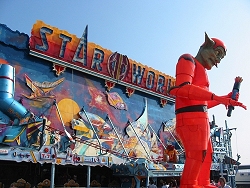 Nowadays, you almost can't move for spinning coasters. Between them, Maurer and Reverchon have flooded the market with rides that range from excellent to poor, and everything in between. Perhaps, though, as we wade through this saturated market, we should remember the ride that for so long kept the flag flying for the spinning coaster concept. Nowadays, you almost can't move for spinning coasters. Between them, Maurer and Reverchon have flooded the market with rides that range from excellent to poor, and everything in between. Perhaps, though, as we wade through this saturated market, we should remember the ride that for so long kept the flag flying for the spinning coaster concept.
Imagine the scene. It's 1992, and we're at the legendary Munich Oktoberfest. Among the array of roller coasters, spin rides, dark rides, sideshows, and other oddities, a new sight homes into view. Presented by showman Klaus Renoldi, this behemoth consists of a truly gigantic building, bearing the name "Magic Mountain". Perched above the entrance is a giant animatronic gorilla, waving apiece of roller coaster track in his humungous hairy hand. Every minute or so, a long roller coaster train skims beneath the primate's posterior, its cars spinning wildly as they go. Clearly this is more than just a big dark ride, it is a fully enclosed and fully portable dark coaster, an ambitious project even by German fair standards. 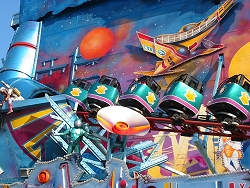 Let's skip forward to 1998. The gorilla has been sold, and enthusiasts have been fearing that Magic Mountain was retiring. Fortunately, the coaster remained, resplendent in a whole new decor, and now bearing the name Star World. The gorilla may have been no more, but this meant that the coaster itself could take centre stage, allowing spectators a much better view of what the ride actually was. Whereas re-theming existing rides often results in fairly insipid efforts (such as Thorpe Park's Rumba Rapids, or Phantasialand's Temple of the Night Hawk), Star World revels in its new identity, and has a unique look, combining the stature of a theme park ride with the OTT glitz of the fairground, with a touch of Blackpool-esque charm for good measure. Let's skip forward to 1998. The gorilla has been sold, and enthusiasts have been fearing that Magic Mountain was retiring. Fortunately, the coaster remained, resplendent in a whole new decor, and now bearing the name Star World. The gorilla may have been no more, but this meant that the coaster itself could take centre stage, allowing spectators a much better view of what the ride actually was. Whereas re-theming existing rides often results in fairly insipid efforts (such as Thorpe Park's Rumba Rapids, or Phantasialand's Temple of the Night Hawk), Star World revels in its new identity, and has a unique look, combining the stature of a theme park ride with the OTT glitz of the fairground, with a touch of Blackpool-esque charm for good measure.
Standing before Star World is an experience in itself. The ride is simply massive, and although it is a cliche (at Coaster Kingdom, we avoid cliches like the plague), you can't stop yourself wondering how on Earth the ride could possibly travel. As if the ride itself weren't impressive enough, a new feature has been added since the re-theme; a natural successor to Magic Mountain's gorilla in the shape of a gigantic robot/alien creature, as tall as the ride itself, who stands at the entrance and serves no purpose other than to attract the attention of passing potential-punters. 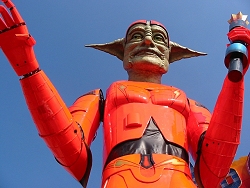 Fully animated, this gentle giant in his day-glo orange space suit spends his days inviting people inside in a variety of languages. If Star World were a theme park ride, this figure's presence would be commendable; that anyone would go to the effort of packing him into a lorry and taking him on tour is astounding. Fully animated, this gentle giant in his day-glo orange space suit spends his days inviting people inside in a variety of languages. If Star World were a theme park ride, this figure's presence would be commendable; that anyone would go to the effort of packing him into a lorry and taking him on tour is astounding.
Now, I don't know about you, but when a 100ft robo-alien tells me to do something, I don't argue, and so I head for the pay box, ready to hand over the very reasonable asking price. Ticket in hand, we pause only to chortle at the various Star Wars figures that have had their appearances hastily altered to avoid the wrath of George Lucas's lawyers, and continue to the loading platform. As is the norm at German fairs, the staff are incredibly efficient, and know exactly what it takes to keep the crowds moving on the rare occasions when a queue manages to build up. As the gates open, you envelope yourself in the deep cocoon-like cars, lower the Break Dance-style overhead lap bar, and prepare for blast-off. 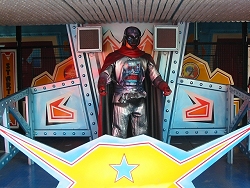 Star World is unusual in that it begins with both a lift hill and a launch. The train slowly climbs around the three inner walls of the building, allowing you plenty of time to take in the laser and lighting effects that fill the void of space. Above your head, some rather tacky Ghost Train style monsters try to intimidate you, and soon the front of the train crests the rise and begins to creep out into the open air. A countdown begins, and on "zero", the train accelerates and zips out for the crowds to see. This will be your last sighting of Earth for a while, so make sure to breathe in the atmosphere (fortunately for you, nowhere on Earth has more atmosphere than a German fair) Star World is unusual in that it begins with both a lift hill and a launch. The train slowly climbs around the three inner walls of the building, allowing you plenty of time to take in the laser and lighting effects that fill the void of space. Above your head, some rather tacky Ghost Train style monsters try to intimidate you, and soon the front of the train crests the rise and begins to creep out into the open air. A countdown begins, and on "zero", the train accelerates and zips out for the crowds to see. This will be your last sighting of Earth for a while, so make sure to breathe in the atmosphere (fortunately for you, nowhere on Earth has more atmosphere than a German fair)
After this bust of daylight, the train returns to the inky blackness for the remainder of the ride. The track proceeds in a seemingly endless series of long sweeps, turns and figure-of-8s that effortlessly flow from one end of the building to the other. Every turn seems designed to encourage the cars to spin a little more, while the pace of the ride never seems to slow, keeping the excitement going until the last moment. 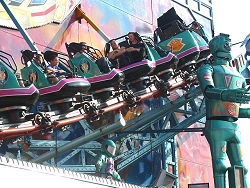 However, Star World is more than just a coaster in pitch darkness. Throughout the ride, laser beams and spotlights do their best to heighten the sense of disorientation, while the finale of the ride sees a large fireball erupt from the ground. Well, to be precise, 50% of riders see a fireball erupt from the ground, as the other 50% will be facing the wrong way. C'est La Vie. Even the brake run is spiced up, taking place within the kind of revolving tunnel usually reserved for dark rides and walk-throughs. Bear in mind that the car itself is likely to be still spinning, and you've got a recipe for some serious disorientation. However, Star World is more than just a coaster in pitch darkness. Throughout the ride, laser beams and spotlights do their best to heighten the sense of disorientation, while the finale of the ride sees a large fireball erupt from the ground. Well, to be precise, 50% of riders see a fireball erupt from the ground, as the other 50% will be facing the wrong way. C'est La Vie. Even the brake run is spiced up, taking place within the kind of revolving tunnel usually reserved for dark rides and walk-throughs. Bear in mind that the car itself is likely to be still spinning, and you've got a recipe for some serious disorientation.
As we pass through the air lock and make our re-entry into the Earth's atmosphere, the staff leap into action, straightening the cars ready for the next troop of space cadets. There's no quarantine procedure for returning astronauts, as the staff sent us on our way at warp-speed. Star World is truly a one-of-a-kind ride. The sheer audacity of travelling such a gigantic structure is something that has to be applauded, and suggests that the ride should be an awful lot more famous than it actually is. It is the kind of ride that any theme park would be proud of, and the only thing that seems to stop it being revered as a true classic is the fact that it has spent its entire existence in the shadow of legendary white-knuckle portable coasters such as Eurostar, Olympia Looping, and the much-missed Thriller. This is a great injustice, as it is a truly excellent "fun" coaster that really can be enjoyed by the whole family. 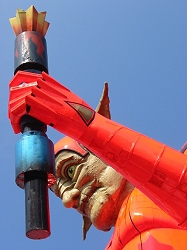 Criticisms? Well, it's harsh, but it's true that the amount of spinning does vary massively from one ride to the next. If your car gathers a little momentum, you can be sent spinning and tumbling through the cosmos like a deranged asteroid. Criticisms? Well, it's harsh, but it's true that the amount of spinning does vary massively from one ride to the next. If your car gathers a little momentum, you can be sent spinning and tumbling through the cosmos like a deranged asteroid.
However, if you're unlucky, you'll get a fairly moderate ride, in which case you'll find that the various lighting effects aren't enough to grab the attention on their own. It feels wrong to criticise the ride in this way, especially as there are plenty of static dark coasters that do a lot less to grab riders' attention, and plenty of spinning coasters that offer far less spinning than even a "bad" ride on Star World. There are plenty of dark coasters in the world, but very few have the panache to really explore the potential of the concept. Star World takes an unusual approach to spicing things up, and as a result is not only one of Europe's better dark coasters, but is also probably Europe's top spinning coaster. Do as the giant robot says, and sign up for a voyage into Star World. It's cosmic. Please, do not use our ratings to compare rides head-to-head. They rate only how well this ride meets its own objectives using criteria that may not necessarily be relevant with similar reviews. 
Good points: - Incredible presentation, both inside and out
- Unusual twist on a tried and tested formula
- Excellent family coaster
Bad points: - Spinning can often be erratic
- Can be slightly rough when cars spin unexpectedly
Labels: Coaster, DarkRides, GermanFairs, SpinningCoaster, Star
Spinball Whizzer, Alton Towers
Sunday, February 25, 2007
We all owe a huge debt of gratitude Charles Talbot, the 15th Earl of Shrewsbury. He transformed a barren area of the Staffordshire countryside into the elegant landscape that we know as Alton Towers. He created the gardens, the lakes, and everything that made it one of the most extraordinarily estates in the world. It was his life's work, his pride and joy. He died in 1827, and as a tribute to him, his nephew John Talbot, the 16th Earl, built the Choragic Monument at the entrance to the gardens, inscribed "He made the desert smile". Interestingly, research suggests that Charles was never quite satisfied with the end product, and unverified reports suggest that newly discovered documents record his last words as follows: "I hope that some day, some kind person will finish my work by building a great big pinball-themed roller coaster right opposite my front door". At long last, in 2004, a mere 177 years after his death, Charles' vision was completed, and the estate became home to Spinball Whizzer, a custom-designed spinning coaster from Maurer of Germany. 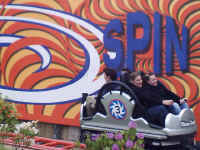 Let me say from the outset that Spinball Whizzer is, if we are looking purely at the two-minutes or so that you're out on the track, a reasonably respectable little ride. With that established, we can start factoring in the various unwelcome elements that turn a neat little coaster into something overwhelmingly irritating and frustrating. The enjoyment of the coaster itself is outweighed by far too many problems, either cosmetic or practical, that force me to the conclusion that the addition of Spinball Whizzer is about as complementary to Alton Towers as a multi-storey car park would be to Stonehenge. Let me say from the outset that Spinball Whizzer is, if we are looking purely at the two-minutes or so that you're out on the track, a reasonably respectable little ride. With that established, we can start factoring in the various unwelcome elements that turn a neat little coaster into something overwhelmingly irritating and frustrating. The enjoyment of the coaster itself is outweighed by far too many problems, either cosmetic or practical, that force me to the conclusion that the addition of Spinball Whizzer is about as complementary to Alton Towers as a multi-storey car park would be to Stonehenge.
If we don a pair of metaphorical blinkers, Spinball Whizzer looks great. It towers above the local greenery, and its silver cars look great as they manically dart and weave among the structure. Maurer’s signature "Immelman" element, in which the track rises until vertical, then turns 180 degrees and drops back to Earth, is nicely framed by a smaller horseshoe turn that threads the main arch. Like a wickedly warped Wild Mouse, the track darts and weaves around the area with tremendous grace. By "normal" standards, it's undoubtedly a good-looking little ride. Now, let's take those blinkers off: Once upon a time, you could walk down Towers Street and see the genuine majesty of Alton Towers. You could walk on the lawn, admiring the wonderful sight of the Talbots' ancestral home, and marvelling at the timeless beauty of it all. Those days are gone. Nowadays, the whole area is clogged up with the kind of tacky paraphernalia that would look fine in any other park, but which destroys the dignity that was once Alton Towers' hallmark. To your right, as if to emphasise the permanence of this disregard for tradition, is the bright red tangle of track that is Spinball Whizzer, complete with accompanying soundtrack of roars and hisses from the ride's machinery, and the yells of its riders. The contrast between the beauty of the towers, and the ultra-modern style of Spinball Whizzer simply looks wrong, sounds wrong, and feels wrong. In all the years that Alton Towers has operated as a theme park, there has always been a feeling that great care has been taken not to infringe on the park's great history. Spinball Whizzer is an unmistakable omen that this is to be consigned to the history books. Oh well, they were nice while they lasted. 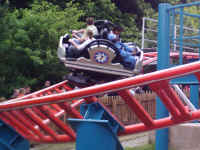 One thing that was immediately obvious when Alton announced their intention to build a Maurer spinning coaster was that these rides, with their "Wild Mouse" type capacity, would generate outrageous queues. Indeed, the precedent had been set by the Vekoma-built "Alton Mouse", which generated gargantuan queues until its removal in 1991. Nevertheless, we thought, Alton Towers must have considered this, so let's take a look to see what ingenious scheme they've concocted to relieve the crowds: One thing that was immediately obvious when Alton announced their intention to build a Maurer spinning coaster was that these rides, with their "Wild Mouse" type capacity, would generate outrageous queues. Indeed, the precedent had been set by the Vekoma-built "Alton Mouse", which generated gargantuan queues until its removal in 1991. Nevertheless, we thought, Alton Towers must have considered this, so let's take a look to see what ingenious scheme they've concocted to relieve the crowds:
Well, there' not a lot to report, to be honest, and certainly nothing I can say that would be remotely positive. The queue for Spinball Whizzer is definitely not its finest point. In the grand Tussaud's style, it weaves among the structure of the ride, but is an open invite to queue jumpers, as one hop over the right fence here and there can skip giant chunks of the queue, while offering little risk of being spotted by the staff. What about Fastrack (AKA Virtual Queue)? Amazingly, this is conspicuous only by its absence, meaning that you either wait your turn, or you don't ride at all. Actually, that's not quite true, there is one method which will allow you to bypass the queue completely, and the park isn’t exactly secretive about what it is. The entrance to the ride is marked by a large pinball scoreboard, with numbers whirling around feverishly. To the left is a sign saying "ENTRANCE". To the right, "PASS HOLDER ENTRANCE". That's right, should you stay in the Alton Towers Hotels, you will be given a pass that entitles you to walk straight onto the ride. Better still, the pass holder path directly shadows the last part of the main queue (approx 45 to 60 minutes worth of queue), enabling you to flaunt your superiority right in the faces of the poor souls in the normal queue. Arriving en masse? Don't worry, you can all hop straight onto the ride, and everyone else can abandon any hope of the queue moving in the immediate future. Now, I don't particularly begrudge the hotel guests being given priority passes per se, but I do object to the way Alton Towers has chosen not to let them on discreetly, but rather to parade their preferred customers under the noses of those who have had the "audacity" to confine their visit to a single day. In short, it seems to be a fairly shameless way of reminding you that the more you pour into the Alton Towers coffers, the better they'll treat you. 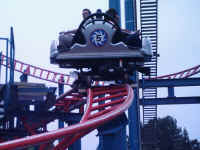 However, what the priority pass holders don't get is the opportunity to play a series of pinball related games. These are scattered through the queue, with approximately one for every half hour of waiting. All consist of a single button that triggers a blast of air, propelling a silver ball to the top of the machine, with points awarded depending on where it lands. While a nice addition, these games provide little more than five seconds of amusement in what is a very slow and frustrating queue. However, what the priority pass holders don't get is the opportunity to play a series of pinball related games. These are scattered through the queue, with approximately one for every half hour of waiting. All consist of a single button that triggers a blast of air, propelling a silver ball to the top of the machine, with points awarded depending on where it lands. While a nice addition, these games provide little more than five seconds of amusement in what is a very slow and frustrating queue.
The only other in-queue entertainment is the constant music. Generally, this consists of a similar playlist to the WWTP radio station in Thorpe Park's Amity Cove, featuring classic Americana from the likes of Elvis, the Beach Boys and The Monkees. With no speech in between, and with an odd tendency to throw in the occasional piece of modern dance music, it lacks the atmosphere of Thorpe's version, but does at least help to make the wait a little more tolerable. Again, however, there is a niggling feeling that this Americanised atmosphere is inappropriate in a park that used to be the very definition of British grandeur, but if you can eradicate such thoughts, it helps to make your wait a more tolerable one. Now, if you're getting frustrated about how long I've spent going on about the queue without starting on the ride itself, then consider that an accurate simulation of what it feels like to wait for Spinball Whizzer. You will be glad to know, however, that the end is nigh as we inch towards the silver hut that is the station. Mercifully, there are no hidden cattle grids in the queue, and the path leads straight to the loading platform, where all the usual station announcements are made by a highly enthusiastic character, who preceeds and proceeds every announcement with "Woohoo", "Wahey", and other such exclamations. The station itself is a rather plain affair, unthemed but for a series of pinball bumpers in the ceiling, and the occasional pinball-related word written on the wall. As with all Maurer spinning coasters, each car seats four riders in a 2x2 back-to-back formation. Although awkward to climb in and out, the cars are very comfortable once seated, and the large lap bar is nice and snug, offering a tremendous sense of security. The silver cars are undecorated but for the park's name and car number, which is a shame, but appropriate to the idea of the theme. Soon, you leave the station, past the "BALL IN PLAY!" sign that adorns the service hut, and up the lift hill. 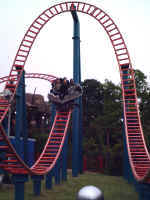 The lift hill is swift, and soon the first drop arrives. Unlike Maurer's travelling version of the ride, the car is free to spin right from the off, and our budding Tommies are plunged into a spiral drop, reaching around half way to the ground, before hopping back into a set of block brakes. From the brakes, the car embarks on a long straight drop, followed by the Immelman, with these two elements presenting a quite imposing sight, being the most prominent section of the ride for passers-by. The lift hill is swift, and soon the first drop arrives. Unlike Maurer's travelling version of the ride, the car is free to spin right from the off, and our budding Tommies are plunged into a spiral drop, reaching around half way to the ground, before hopping back into a set of block brakes. From the brakes, the car embarks on a long straight drop, followed by the Immelman, with these two elements presenting a quite imposing sight, being the most prominent section of the ride for passers-by.
The Immelman is OK, but lacks the sense of mania that other Maurer spinners seem to offer. Facing downwards, it offers good visuals, but is something of an anti-climax for anyone expecting anything particularly thrilling. Far more enjoyable is the proceeding swoop back in and out of the structure, and back through the Immelman arch, which has a nice flowing quality to it. All that's left now is a nice drop into a good ground hugging helix, and a final back-and-forth zigzag to the brake run. Don't let your guard down, though, as the device that straightens the cars relies on very basic technology and is not subtle, being more than capable of giving a quite aggressive thwack to unsuspecting riders. On the plus side, the ride feels nice and long, and is wonderfully smooth, which is a relief, given that 50% of the time you can't see what's coming and prepare accordingly. Some of the changes of direction are wonderfully subtle, and it does seem that Maurer have really made the spinning coaster concept their own. Unusually, the highlights are the dives to and from the various block brakes, which offer a wonderfully disorientating transition from chaos to calm, and back, as well as providing a slight pop of airtime if you're lucky. As for the downers, well, for a spinning coaster, there seems to be one quite startling omission. Spinning. Only the hops onto the various block-brakes seem to persuade the cars to move at all, whereas much of the "proper" sections of track see the cars stick rigidly in whatever position they have chosen. Compared to the wild spinning offered by some of Reverchon's Crazy Mouse coasters, you get a distinct feeling that Maurer's cars would welcome a liberal dose of WD-40. While you can argue that a pinball theme does not suit the park, you can't deny that it opens up a huge array of potential tricks and effects. The Maurer-designed Winja's coasters at Phantasia Land include such features as see-saw track, which would have suited the pinball theme beautifully. Spinball Whizzer could have been a real showcase for what Maurer can do with the concept, and yet this potential remains entirely untapped, leaving a relatively coaster that is little more than a simple re-shuffle of the elements found on the travelling version. As for the in-ride theming, this consists of little more than the occasional bumper-tower here and there, which is a real waste of a gilt-edged opportunity to do something truly spectacular. Similarly, the ride fails to exploit the possibility of in-ride effects such as endless chaotic head-choppers and sound effects as the car darts around the structure, meaning that riders have very little to watch out for during the ride. Considering that the idea is that you are the ball in a pinball table, you'd be forgiven for expecting a bit more razzamatazz. A real pinball table is a fast-paced extravaganza of action, lights, sounds, and anything else the designers can chuck into the mix. By contrast, Spinball Whizzer's decor could not be more bland and insipid if it tried. Now, observant readers may be wondering whether this is the same Coaster Kingdom that has heaped praise upon Dragon's Fury, Spinball Whizzer's sister ride at Chessington World of Adventures. Well, while Dragon's Fury is certainly the better and more interesting ride, it also suits Chessington in a way that Spinball Whizzer does not suit Alton Towers. Both rides fall somewhere between the categories of "family ride" and "thrill ride", and as a result of this, Dragon's Fury works perfectly as a relatively major ride in a park intended for young families. Spinball Whizzer, meanwhile, is forced to cater to both audiences, the young families and the thrill seekers, and simply does not have the capacity to do so. As a result, family groups are charged with the task of keeping the youngsters amused as they plod interminably through a soul-destroying queue, while older groups are going to be frustrated to find that they've queued longer for Spinball Whizzer than they would for Nemesis or Oblivion (or, quite possibly, the two combined). Building Spinball Whizzer at Alton Towers was like housing a Rolf Harris sketch in the Louvre. Individually, it might be a fairly entertaining piece, but it should not be there, and makes its surroundings less dignified than before. It simply had too much to do in terms of trying to entertain too great a proportion of the park's visitors, without infringing on the park's unique landscape. As a result, it fails on both counts, being garish enough to cheapen the area, while not garish enough to create the illusion of a giant pinball machine. It makes you wonder why the pinball theme was chosen, given that it was never really going to work in such a location. In short, Maurer has designed a respectable little family coaster that would work extremely well in many parks, but which totally ignores the fact that Alton Towers regularly attracts crowds beyond what the ride can handle. As a result, actually getting to ride it involves far more hassle than it's really worth. Given that Spinball Whizzer has much lower capacity than any of the parks main three coasters (Nemesis, Oblivion, Air), and appeals to a much higher proportion of visitors, I can't really recommend Spinball Whizzer to you unless you happen to visit on a very quiet day indeed. "Fair enough" you might say, but there's one unavoidable proviso - At Alton Towers, "Very quiet days" are all but non-existent. Please, do not use our ratings to compare rides head-to-head. They rate only how well this ride meets its own objectives using criteria that may not necessarily be relevant with similar reviews. 
Good points: - A fun, relatively smooth, and fairly long ride
- Comfortable and a ride that all the family can enjoy
Bad points: - Fails to blend in with the surrounding area and doesn't exploit the theming opportunities
- Capacity is well below what is required, and due to the popularity of the ride, you should expect sizable queues
Labels: AltonTowers, Coaster, Maurer, SpinningCoaster
Winja's Fear and Force, Phantasialand
Sunday, February 25, 2007
This article contains spoilers. If you read on, please be aware that surprises or secrets may be revealed in great depth We humans are a curious lot. Despite around a quarter of the planet remaining uncharted, we have broadened our horizons of discovery to the furthest fringes of our solar system and beyond. Our inquisitiveness has yielded the discovery of extinct breeds of animal, as well as the unearthing of long-lost civilizations. Yet, it wasn't until 2002 that the ancient underground empire of Wuze Town was discovered at Phantasialand in Bruhl, Germany. Wuze Town is a mythical middle-earth civilization dating back to 850AD where women rule on the banks of Moon Lake. Despite it being notable only by its absence over the last ten centuries, the entrance to Wuze Town is hardly recluse; a huge facade of tan-coloured crazy paving is brought to life with a whimsical and almost Gaudi-like entrance area set behind an exotic fantasy garden. The entrance is decorated with a pair of whimsical turrets, decorated like giant cobbled feet with a water feature bubbling over a wooden wheel-like structure behind. Wuze Town is essentially a large bazaar, although ingeniously incorporates a complex labyrinth of pathways and balconies that climb up into the upper pinnacles of the building. This of course offers a heightened sense of exploration and discovery, whilst also affording unique views of Winja's Fear and Force orbiting their way around hairpin turns before dropping into large sweeping spirals around the highly themed observation ride, Tittle Tattle Tree which itself climbs towards the enormous glass atrium above. 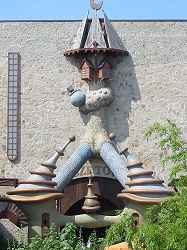 In the deepest recesses of the building, beyond a bustling marketplace, you'll find Winjas. The entrance takes you into a dark vault, towards a sculpture of a middle-earth type creature, with a hawk-like beak, light flaring from golden eyes with a claw cradling a pink egg. In the deepest recesses of the building, beyond a bustling marketplace, you'll find Winjas. The entrance takes you into a dark vault, towards a sculpture of a middle-earth type creature, with a hawk-like beak, light flaring from golden eyes with a claw cradling a pink egg.
A staircase wraps around this statue and takes you up into the main queue hall. The walls are decorated with a battalion of dark, mysterious characters, hawk-eyed in the darkness looking down on you. The queue can look bewildering, but it splits early to establish which of the courses you're going to engage battle with; Fear or Force. Frankly, at the queue-line stage, the distinction between the two is vague at best. Unlike other duelling rides like Duelling Dragons where the distinction is made crystal clear not only by the split in the queue, but also by things like the colour of the track, I don't think it would take a complete moron to miss not only the fact that there are two rides intertwining, but also the fact there are two coasters signposted as Fear and Force, especially on a quiet day when the split doesn't occur opposite a large mural decorated with Fear and Force respectively pointing in opposite directions. That said, such pensiveness might actually work to your benefit. One of the benefits of having two coasters is that it effectively doubles the capacity of the attraction and how many people it accommodates on an hour-by-hour basis. If both rides are marketed unequivocally as being separate - and indeed unique, then much of the benefit of two rides is made redundant as people would ride both Fear and Force. 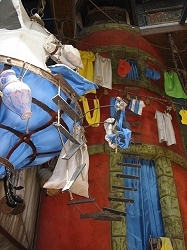 Perhaps in-keeping with some of the hostile environments the great explorers such as Indiana Jones and Frodo Baggins, the queue is stuffy and uncomfortable. The dark and subdued lighting adds to the atmosphere, but the mass of people in a small room means on a hot day it will feel more like a sauna over an ancient civilisation. Perhaps in-keeping with some of the hostile environments the great explorers such as Indiana Jones and Frodo Baggins, the queue is stuffy and uncomfortable. The dark and subdued lighting adds to the atmosphere, but the mass of people in a small room means on a hot day it will feel more like a sauna over an ancient civilisation.
The two queues run parallel as they descend down a staircase down into the deepest depths of Wuze Town and onto the station platform. Despite the two sides always being referred to in unison and in order as 'Fear & Force' (much like Bangers & Mash or Romeo & Juliet), confusingly, Force queuers are on the left hand side, whilst on the control room opposite, the ride's name, "Winja's Fear & Force" further blurs the line of distinction between the two sides. The platform is tiny, accommodating the unload position of the cars where they advance to the load position where riders are held behind airgates. The set up of the station is cramped, but against all odds seems to work. Even at this late stage in the queue where the practicalities of a station should take precedence over a consistent theme, absolutely nothing is missed. Operators are in costume, the station is decorated with elaborate trimmings such as heavy curtains, and the cars are probably the most ornate I've ever seen. Almost appearing to have been carved out of stone, the feminine face of Fear/Force decorates the side of the cars, with ornate finishings such as delicate obelisks and detail on the very top of the car. Fear Riders sit in pairs, back to back. The lapbar is very snug, and effectively cocoons you into the deep seat. With a quick check, the car advances towards two massive doors that swing out of the way before you stop in front of two more doors. A huge lantern flickers above with a statue depicting Fear/Force cradling a flame in her cupped hands before two more doors open, you advance forward and stop. After the hustle and bustle of Wuze Town, as the door closes behind you and the car is plunged into darkness, you suddenly feel very insular. A brief moment of anticipation recedes as the car suddenly and quickly is lifted from the ground vertically though the darkness to a height of 60 feet. As you approach the top, the track smoothly tilts downwards almost as if to taunt forwards facing riders with a view of the steep drop and adding to the sense of overwhelming curiosity for backwards facing riders. In just a few moments, with a satisfying clunk, the car suddenly launches itself down a steep drop with fleeting glimpses of Force to the left of the direction of travel. Following the sweeping first drop, the car climbs up towards the ceiling arching through an exquisite camelback hill before climbing up and through the first block brake. 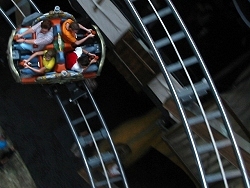 From this point on, your car is free to spin, and does so first though a series of elevated wild mouse turns. In a feature absent from both Dragon's Fury and Spinball Whizzer, these turns really serve little more than a scenic break from the onslaught of the rest of the ride, being neither particularly forceful, nor encouraging towards getting the cars spinning. From this point on, your car is free to spin, and does so first though a series of elevated wild mouse turns. In a feature absent from both Dragon's Fury and Spinball Whizzer, these turns really serve little more than a scenic break from the onslaught of the rest of the ride, being neither particularly forceful, nor encouraging towards getting the cars spinning.
Having passed through this slalom, the car pitches to the side and swoops around the main atrium of Wuze Town through a sweeping helix. Force swoops overhead as you suddenly become the object of onlooker's exclamation as you pass close enough to eavesdrop on their conversations. After this prolonged flyby, and a brief kiss from some mid-course brakes, you drop into the darkest halls of Wuze Town, climbing suddenly and almost vertically up through a tight immelman turn, swooping out into the light again almost as a token formality before diving down a steep drop back into the darkness, abruptly climbing up a sharp rise on which you suddenly stop, perched precariously on the end of some dead end track. As if this predicament wasn't dramatic enough, a stirring orchestral melody explodes as the entire stretch of track tilts downwards as if guided by some malevolent force and the car drops into a tight right hand turn, weaving around to the left and stopping on the final brakes. Even the final slalom through pitch darkness from the brakes to the station throws some pepper on the goulash as the track drops briefly from under you before bouncing back up and returning you into the station - a subtle effect, and somewhat wasted, but certainly makes a dull gait something more interesting. Winja's Fear  Force The beautiful thing about Fear and Force being twins is that if you like one, you'll like the other, yet each offer their own individual character. Like Fear, Force gets off to a familiar start; you queue in the same hall, descend down the same staircase onto the same platform. This time you load to the left, and like Fear, your four-seater car is tyre driven straight out of the station, into a vault and then beyond into a dark, enclosed elevator. No time to waste as your car is sensationally lifted 60ft in a matter of seconds, smoothly tipping you into a sweeping first drop, curling elegantly towards the upper echelons of the glass atrium, rolling around to the right and sweeping along the length of the hall through a series of subtle undulations before hitting the first straight into a run of hairpin turns. 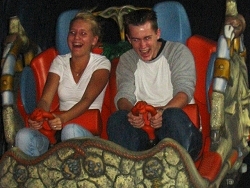 Akin to Fear, your car is now free to spin, and passes through the fairly rudimentary elevated hairpin turns, treating riders to a particularly sharp turn out of a set of brakes at the end of this element before spiralling into the same 65ft diameter carousel helix as Fear, briefly passing over Fear and then pulling into a straight back towards the entrance of Wuze Town. Akin to Fear, your car is now free to spin, and passes through the fairly rudimentary elevated hairpin turns, treating riders to a particularly sharp turn out of a set of brakes at the end of this element before spiralling into the same 65ft diameter carousel helix as Fear, briefly passing over Fear and then pulling into a straight back towards the entrance of Wuze Town.
In the shadows of the earlier hairpin bends, your car buries itself into the far corner of the building, scurrying into a tight corridor of pillars and walls, down a subtle drop and then plummeting into a sublime drop past a cascading waterfall down to the water below and past one of the best vantage points in the whole of Wuze Town before going off piste and into the darker recesses of Wuze Town. As soon as the light fades, your car stops suddenly, and as your eyes become accustomed to the darkness, you realise you're perched on a straight of track that goes absolutely nowhere. Before you can even comprehend an escape route, the entire stretch of track - train and all - tips sharply to the side, joining up with another curve of track before you are launched into a sweeping S-turn, finishing just how Fear finished, with a final section of trick track leading you into the station. Winja's Force  Summary Judged individually on their own merits, both Fear and Force are the epitome of sublime. Like Dragon's Fury at Chessington, Winja's can confidently be filed under 'Fun', and raises a smile from even the most sombre of rider, whether young or old, a white knuckle fan or family fan. Fear is, in my opinion, without a doubt the better of the two. It has a far more spectacular opening with a massive straight drop into an oversized camelback hill, and has a better and more composed middle section following the main helix making use of the extra 200-or-so feet of track length at it's disposal. Force, however, is hardly a turkey. The comparably lacklustre start is offset by a wonderful stint along the back wall of Wuze Town with a wonderful drop past a large waterfall and into the darker regions of Wuze Town. Neither ride escapes criticism, however petty. The Wild Mouse hairpin bends on both are fairly tame, but to their credit adds variety to an already fruity medley of elements. The main criticism seems to be when the rides leave the main hall and enter a darkened hall in the back of Wuze Town. Whilst the hall is dark, it isn't dark enough to disguise the fact it is unthemed and by the same token, ugly. It is similar to the warehouse section on Colorado Adventure, where you unquestionably profit from the darkness, but cannot escape the fact you're just in a large, dark room. Again, almost as if to weaken my own argument, this is a moot point on an otherwise elaborately themed ride. Both of the tracks interact well with the pathways around Wuze Town, and indeed the Vekoma Mini-Paratower, Tittle Tattle Tree. Ignoring the 'dark room', nothing has been missed with regards to the theme. Supports are disguised as wooden pillars and are often built into the building itself supporting the balconies and roof above. Also, the pillars supporting the wild-mouse-style turns at the beginning of the ride rise out from strange little tent-come-buildings. Silly little details like this abound, and - it's a cliche - but often up to Disney standard. Even ignoring the trick track sections, each of these rides holds it's own against other family coasters, and like most Maurer spinning coasters has a broad appeal. But, add to this unusual elements such as the see-saw, the tilting track and the drop track towards the end of the ride, as well as other unique elements such as the vertical lift, and you have a ride that uses not only attention-seeking tricks to embed themselves into your memory, but also a varied, action-packed layout to ensure that you'll enjoy it ride after ride. I'll be honest here and say that my main concern with Winja's Fear and Force was that the trick track elements would be intrusive and break up and flow that the coasters had, but each punctuates the transition into a new 'chapter' of the ride well - from the main hall, into the coaster's final curtain and both the tilting track and see-saw are quick enough to mean that every moment is one to be savoured, and not intruded upon by logistical clutter such as the stopping of the car or the aligning of the track. At 40ft and banked at 80-degrees, Fear's Immelman turn is hardly statistically note-worthy, but is fast, sudden and a complete surprise as it is hidden away to all but the most inquisitive - consequently, it is one of the best executed versions of this element to date. Both coasters also profit immensely by their original setting - both enclosed, but certainly not in the traditional sense. In fact, there's very little traditional about either of these coasters, but each has enough substance to guarantee that you'll enjoy every ride and that it doesn't solely rely on wafer-thin tricks to impress. Phantasialand and Maurer have both respectively struck gold. Winjas shows off Maurer's capabilities in the very best light, whilst Phantasialand have looked outside the box when it comes to hosting a wonderful family roller coaster with universal appeal. Phantasialand have unearthed a wonderful 'town', and a near faultless coaster. Please, do not use our ratings to compare rides head-to-head. They rate only how well this ride meets its own objectives using criteria that may not necessarily be relevant with similar reviews. 
Good points: - Two fantastic coasters, and twin tracks means double the capacity
- Original tricks on each, including vertical lift, seesaw, tilting track and falling track
- Both have varied layouts, great cars, superb theming and offer a generally smooth ride
- Great interaction with pathways around the building, and a nice enclosed setting indoors
- Much of the theming is excellent, and a very original theme
Bad points - The enclosed sections are sparse and unthemed
- The hairpin bends on both are tame, and Force has an uninspiring start
- The benefits of having twin tracks may be wasted as people will inevitably ride both
Labels: Coaster, Maurer, Phantasialand, SpinningCoaster
Dragon's Fury, Chessington World of Adventures
Saturday, February 24, 2007
 The legend of St. George has it that a pagan town in Libya was terrorised by a dragon, and as the mutton it fed on waned, citizens were sacrificed in order to control the dragon and supplement its irrepressible diet. Hearing of the impending fate of a local princess, Saint George went to her aid, succeeding where armies had failed in slaughtering the flame-throwing serpent and saving the fair maiden. The legend of St. George has it that a pagan town in Libya was terrorised by a dragon, and as the mutton it fed on waned, citizens were sacrificed in order to control the dragon and supplement its irrepressible diet. Hearing of the impending fate of a local princess, Saint George went to her aid, succeeding where armies had failed in slaughtering the flame-throwing serpent and saving the fair maiden.
Dragons have played an important part in the cultural heritage of mythology the world over, just as dragons have been prevalent in the heritage of Chessington World of Adventures, too. But Chessington wasn't saved from a dragon; it was saved by a dragon - it was just that this dragon came in the form of a Maurer Sohne spinning roller coaster. Now, spinning coasters aren't particularly new. One of the most famous spinning roller coasters of recent times is Star World (formerly Magic Mountain) that tours the German fairs. This was a custom made ride featuring a long train of egg-shaped cars free to spin throughout the enclosed ride. But even before Star World, the Virginia Reel was a popular ride at parks like Pleasure Beach Blackpool featuring a zig zag on the side of a fake mountain which would spin the tub like cars before they'd drop through a series of turns into tunnels.  A more modern comparison to the Virginia Reel is the popular spinning coaster from Reverchon. With a course based on the popular Wild Mouse with unbanked sharp hairpin turns and abrupt drops, the ride features Waltzer-like cars which upon reaching the second level of the ride would be free to spin. A more modern comparison to the Virginia Reel is the popular spinning coaster from Reverchon. With a course based on the popular Wild Mouse with unbanked sharp hairpin turns and abrupt drops, the ride features Waltzer-like cars which upon reaching the second level of the ride would be free to spin.
Whilst not the best example of a spinning coaster, the Reverchon model did seem to be the catalyst in the recent explosion of spinning coasters. Since the ride debuted at Foire Du Trone, Reverchon has sold over thirty of the units globally, including a pair to Disneyworld, Florida. Since the success of this ride, other manufacturers including Gerstauler and Maurer Sohne have since profited from the idea of rotary roller coasters, refining the idea to include new elements. Whilst Maurer started off with the pocket-sized X2000 coaster, it included new elements such as a spectacular immelman turn, a vertically banked horseshoe of steel galloping skywards.  Maurer successfully dabbled in the idea of custom spinners in 2002 with Winjas, two unique roller coasters featuring not only the celebrated immelman turn, but vertical lifts, see-saws and falling track effects. Maurer successfully dabbled in the idea of custom spinners in 2002 with Winjas, two unique roller coasters featuring not only the celebrated immelman turn, but vertical lifts, see-saws and falling track effects.
Tussauds decided to purchase two of these custom spinners in 2002; one for Alton Towers (Spinball Whizzer), and one for Chessington. Both resisted the urge for supplemental extras such as see-saws, but both would be custom, and both advertised heavily as being family coasters. From head to tail, Dragon's Fury is a 1771ft meander of forest green track supported by a forest of ruby-red supports surrounding the entire new area for 2004; Land of the Dragons. Sprawling across many acres of land, further compounded by the fact that the entrance is actually outside Land of the Dragons, it is no surprise that infrequent visitors often have a quest on their hands to find the entrance.  Once found, however, there is no avoiding the unmistakable signature of Tussauds, where the coaster is presented in quite explicit detail as it performs its spectacular aerial dogfight high above you. Once found, however, there is no avoiding the unmistakable signature of Tussauds, where the coaster is presented in quite explicit detail as it performs its spectacular aerial dogfight high above you.
Like a fireball falling from the sky, a four seater car topples over the top of a 60ft tall lift hill, plunging towards the pathway below, scraping past the ground before sharply pulling up into a vertical (by Oblivion's yardstick) immelman turn before disappearing out of view. This is an opening sequence few family coasters can boast. The entrance is a small hamlet of buildings and archways serving various purposes such as photo collection, Fastrack ticket collection as well as the two entrances to the ride, all decorated with crumbling stone pillars and dragon head gargoyles. Adding flair to an already enchanting entrance area, 'Claudius', an animatronic dragon infrequently rears his head from a cave to the left of the entrance, threatening children who dare touch the treasure he's guarding with a deep roar and an animatronically angsty gesticulation of his outstretched noggin. The queue meanders through a forest of charred trees through a fairly mind-numbing zig-zag in front of the station. The queue isn't great, it has to be said, but it is good to see Chessington's humour, however bad, making a simple no smoking request a bit more interesting;  "What did the big dragon say to the little dragon? You're too young to smoke" "What did the big dragon say to the little dragon? You're too young to smoke"
[token pause for laughter to fade] Before you enter the station, you're counted up into groups of four, pairing up pairs and adding single riders into the mix as necessary. This means that once in the station, delays are kept to a minimum as every car is filled to capacity. So that Dragon's Fury can efficiently gobble up the queue (all part of a balanced diet), the cars don't stop in the station, instead slowing down to a crawl. As well as keeping the cars moving through the station, this also has the psychological benefit of adding a sense of urgency to the loading procedure meaning people get into the trains with far less hesitation than on other comparable rides. Riders sit in pairs, back to back with comfortable lap bars and an O-shaped grab handle which you can hold almost like handlebars on a racing bike.  And so this reign of fire begins by climbing a startlingly quick lift hill. Get ready to savour every moment of what's forthcoming, as it'll be over in half a jiffy. Forward-sitting riders only are privy to knowing when your car will crest the top of the lift - a hint to back seat riders; it's sooner than you think. Without hesitation, the car curls around to the side, falls from orbit down a steep drop and buries itself down into the ground before sensationally pulling up into a vertical climb, turning around a wonderful 180-degree turn on its side before plunging vertically back down towards the ground. And so this reign of fire begins by climbing a startlingly quick lift hill. Get ready to savour every moment of what's forthcoming, as it'll be over in half a jiffy. Forward-sitting riders only are privy to knowing when your car will crest the top of the lift - a hint to back seat riders; it's sooner than you think. Without hesitation, the car curls around to the side, falls from orbit down a steep drop and buries itself down into the ground before sensationally pulling up into a vertical climb, turning around a wonderful 180-degree turn on its side before plunging vertically back down towards the ground.
A straight climb straightens out into a mid-course brake run. Virtually unhindered, the train drops straight down, climbing back up and abruptly turning a 90-degree left-hand turn into another set of brakes. Once again, the brakes offer no break in pacing as the train threads itself through a forest of treehouses and rope bridges through a downward spiral, pulling up into a dreamy camelback hill arching high over Griffin's Galleon (Zierer Kontiki), swooping through a left-hand curve, climbing into another set of brakes.  Untamed, this beast spirals groundwards through a heavily banked downward helix, swooping out into a shallow mid-course lift hill. As this dragon makes a bid for the sky once again, your car still turns before you slalom at roof height through an undulating S-turn, dropping down between a hedge and the back of a building, bouncing abruptly up through a fairly fruitless double up, passing through the last set of mid-course brakes before slaloming down through a final banked S-turn and into the final brakes. Untamed, this beast spirals groundwards through a heavily banked downward helix, swooping out into a shallow mid-course lift hill. As this dragon makes a bid for the sky once again, your car still turns before you slalom at roof height through an undulating S-turn, dropping down between a hedge and the back of a building, bouncing abruptly up through a fairly fruitless double up, passing through the last set of mid-course brakes before slaloming down through a final banked S-turn and into the final brakes.
With a final whip of its tail, a comically rudimentary system of a 10ft long bar thumps the side of the car whilst it passes through the brakes in order to tame the spinning and lock the car so that it can snugly fit back into the station. So is Dragon's Fury hot stuff, or does it just blow hot air? Fury is without a doubt red-hot.  For years now Chessington have been trying to tell us they're a family park as if this was justification for years of neglect and under investment. Since then, Hocus Pocus Hall opened, which, as enchanting as it is, hardly sent waves through the amusement industry. For years now Chessington have been trying to tell us they're a family park as if this was justification for years of neglect and under investment. Since then, Hocus Pocus Hall opened, which, as enchanting as it is, hardly sent waves through the amusement industry.
Dragon's Fury accompanies Land of the Dragons, an area for younger rapscallions including Griffin's Galleon (Zierer Kontiki), Sea Dragons (small round ride) as well as numerous play areas. However, Dragon's Fury is specifically marketed as a family coaster. Traditionally, only Disney can design a good family coaster with any exceptions being accidental as opposed to calculated. With parks being offered a greater choice of family rides by manufacturers, they are now in a better position than ever to offer a ride with true universal appeal as opposed to palming off hand-me-down kids coasters as a 'family ride'. In an age where in terms of roller coasters bigger is better, it is easy to become fazed and actually forget that theme parks are for. They're not supposed to be endurance tests, they're just supposed to be fun. Although the feeling of taking on a coaster and conquering it is often gratifying, it is often refreshing to come off a coaster grinning from ear to ear.  It is this sensation that broadens the appeal of a roller coaster - even the best white knuckle coaster in the world couldn't satisfy as many people as the best family coaster. It is this sensation that broadens the appeal of a roller coaster - even the best white knuckle coaster in the world couldn't satisfy as many people as the best family coaster.
Dragon's Fury bore the heavy responsibility of becoming the park's first new signature ride since Vampire as the theme park headed into a new era. It took on this challenge and won. Even ignoring the objective of this ride, you're left with a ride that is a pure placebo. Children have the feeling of having conquered a major coaster, whilst parents enjoy a ride that is just great fun. Highlights are in abundance. The way the ride goes off almost exploring Land of the Dragons is inspired, and the ride features one of the best opening sequences that can be asked of it dropping down a steeply banked drop into a sensational immalman turn. Even escaping the gaze of voyeurs on the ground, the ride continues through a wonderful bunnyhop and two excellent helices.  The midcourse lift is actually not too much of an intrusion at all, and actually encourages some of the most pronounced spinning in the ride, as does the roof-top meander following. The midcourse lift is actually not too much of an intrusion at all, and actually encourages some of the most pronounced spinning in the ride, as does the roof-top meander following.
The double up is, quite frankly, ineffective, but the swooping s-turn into the final brakes is a good way to finish, if not up to the standard the rest of the ride has set. Nevertheless, the ride is explosive from start to finish without having too much bite for younger explorers. Dragon's Fury will undoubtedly have an indelible effect on Chessington, and if Fury is indicative of the direction Tussauds want to take the park, then I welcome this change with open arms. Please, do not use our ratings to compare rides head-to-head. They rate only how well this ride meets its own objectives using criteria that may not necessarily be relevant with similar reviews. 
Good points: - A true family coaster - can be a challenge for younger kids but keeps parents and teens entertained
- Capacity is adequate, and the queue moves at a reasonable pace, if not fast
Bad points: - Although a family ride, the car design has groups of four back-to-back limiting rider interaction
- Dragon's Fury has quite lazy theming - what there is is fine, but the detail has been scrimped upon
Labels: Chessington, Coaster, Maurer, SpinningCoaster
|